What is Sound Masking ?
Sound masking is the process whereby a modest level of discreet background noise – SOUNDS OF NATURE in the case of the ASD PRIVACY SYSTEM – is added to an environment. This reduces the intelligibility of speech and creates a more pleasant acoustic environment.
This creates a reduction in speech intelligibility and makes the acoustic environment more pleasant.

How does Sound Masking work?
Let’s take an example: Let’s take an example: we are dazzled by the headlights of a vehicle coming towards us on a dark street at night, but not in brighter environments, even though the light intensity is the same – because of the lower CONTRAST/DYNAMIC RANGE.
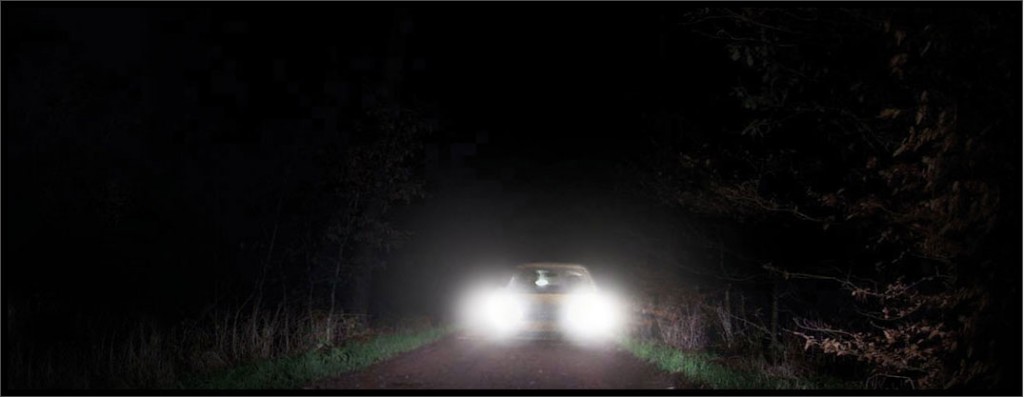
UNPLEASANT, DISHARMONIOUS SITUATION
Bright headlights, total darkness
high contrast = high dynamic range
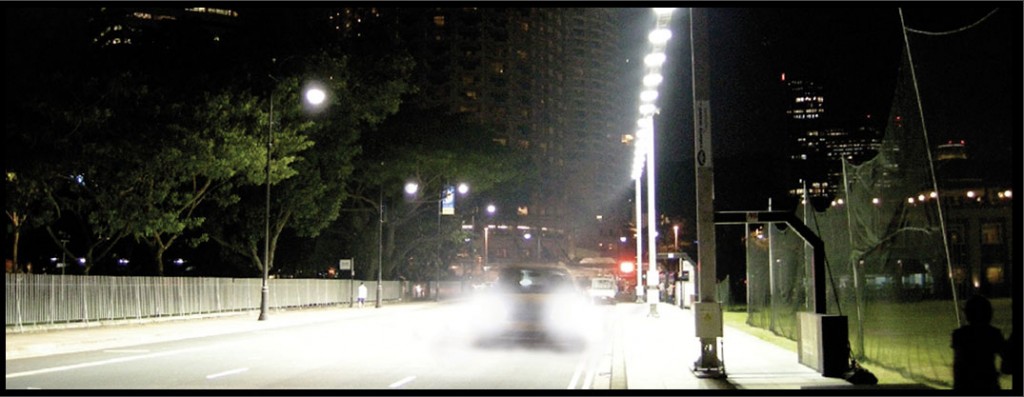
PLEASANT, HARMONIOUS SITUATION
bright headlights, street lighting
low contrast = low dynamic range
THIS PRINCIPLE ALSO APPLIES TO HUMAN SPEECH:
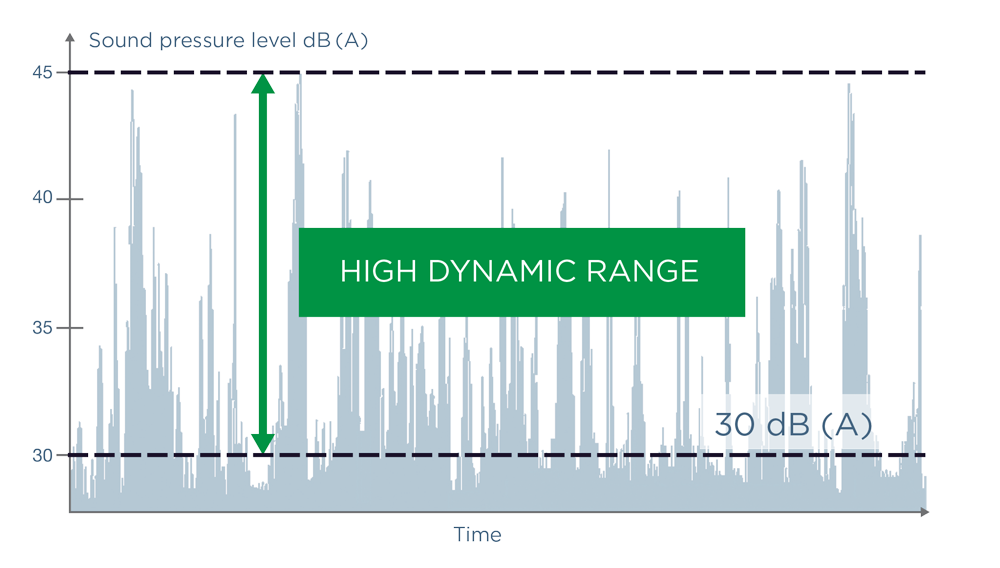
Typical differences in speech sound levels
over a given time
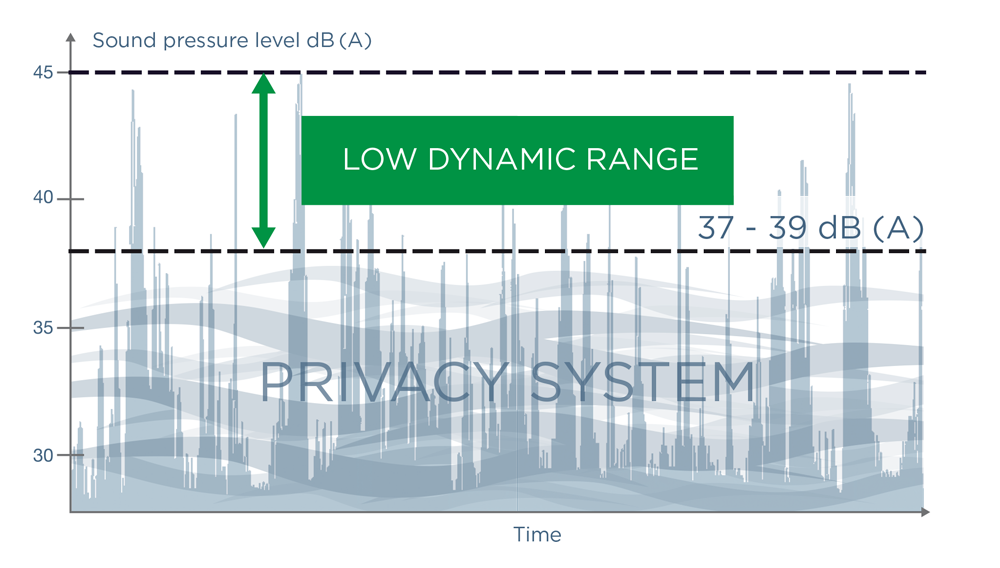
Playing calm background sound reduces
the dynamic range appreciably.
With harmonious sound masking, conversations of others in the same room are much less intelligible and, therefore, less likely to distract us.
Sound masking tends to quieten the total noise volume in a room.
PROJECT EXAMPLE
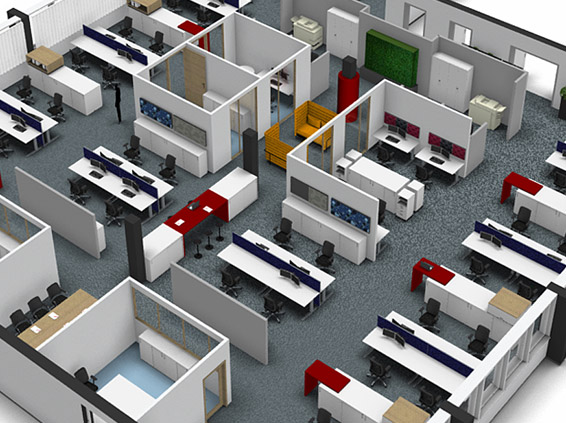
- The installation of a privacy system was incorporated
into the planning of the room acoustics and
its effectiveness simulated on computer. - The planning of fixtures and fittings was done
using a room acoustics 3D model. - The use of a privacy system significantly improved
the different groups’ acoustic working conditions
across the open-plan area.
Speech intelligibility
without ASD PRIVACY SYSTEM
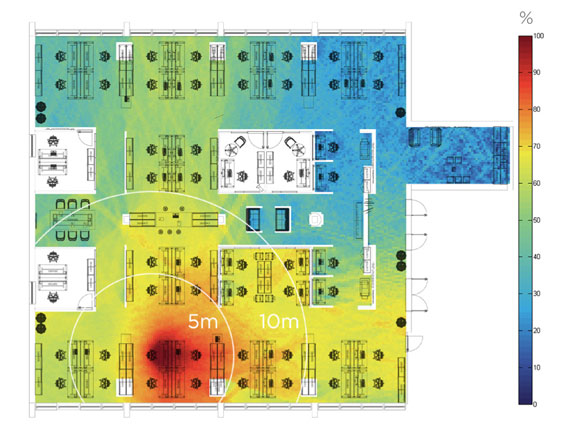
Within a radius of ten metres from the person speaking (red centre) up to 70% of what is being said is still intelligible.
Speech intelligibility
with ASD PRIVACY SYSTEM
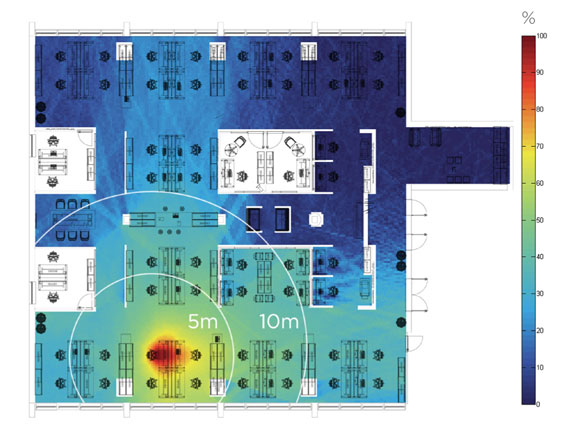
Beyond a radius of five metres from the person speaking only 50% or less of what is being said is still intelligible. The requirements of ISO 3382-3 in relation to distraction distance are fulfilled.
SOUND MASKING FAQ
Who needs a sound masking system?
Sound masking is needed wherever our ability to concentrate is disrupted by intelligible background speech or when we want to protect against unwanted eavesdropping.
These are problems encountered in not only multi-occupancy offices and modern open-plan workspaces, but also customer centres, reception areas, hospitals and establishments with an increased need for confidentiality and data protection, such as insurance firms, health insurance companies, banks and financial service providers. They are also an issue in homes with poor sound insulation and outside noise.
Can sound masking be heard?
If it couldn’t be heard, it wouldn’t work! The sound level of our privacy system is comparable to that of the CPU fans we are familiar with from when we all had PC towers at our desks. Our brain easily blocks out such quiet and constant signals.

Does sound masking suppress noise?
Sound masking does not directly combat noise. Speech is ‘masked’ so that it is more difficult for the human ear to make out what is being said. The sound level of the noise source largely stays the same. In other words, you can still hear that somebody nearby is talking, and they sound as loud as without masking. But you can no longer follow the conversation.
What’s more, experience shows that people automatically speak more quietly when there is sound masking in use as they are no longer as bothered by the surrounding noise. The system also reduces the dynamic range of the space itself, which means the acoustics of a room with sound masking are often much more pleasant.
Is sound masking simply fighting noise with noise?
No, sound masking involves adding quiet, unobtrusive and barely noticeable background noise to an environment – sounds of nature in the case of the ASD PRIVACY SYSTEM. If anything, it reduces the overall volume in the room, as employees now also speak more quietly.
Is sound masking comparable to noise cancelling?
Noise cancelling involves fighting noise with noise. However, this only works at individual points (e.g. in headphones). Therefore, noise cancelling is no use in a room. Sound masking, on the other hand, works in every required part of a room at the same time by adding quiet background sounds.
Is sound masking harmful to health?
According to ASR A3.7 Noise (ASR = technical rules for the protection of employees in workplaces in Germany), a background noise level in the workplace of 45 dB(A) with a maximum rating level of 55 dB(A) is permitted in respect of speech.
There is no reason to worry about the sounds emitted by a sound masking system being harmful to health as long as the maximum permitted background noise level is not exceeded by technical equipment. The ASD PRIVACY SYSTEM plays sounds of nature at sound pressure levels of 37–39 dB(A) in the workplace, 75–84% below the permitted upper limit of 45 dB(A).
Can I get tinnitus from sound masking?
No.
Is sound masking mainly useful for call centres?
On the contrary – almost all employees in conventional call centres are on the phone at any one time. If you assume that 50% of these employees are listening to what their callers are saying, the other 50% or so are speaking at the same time. Their voices overlay to such an extent that the result is gibberish, and it’s practically impossible to make out individual words and sentences, so speech intelligibility is low!
Sound masking is used where a mix of communication and concentration is required. Especially in large multi-occupancy offices, just a few people speaking may be very disruptive to others in the room.
Will I still be able to understand members of my team in my immediate environment?
You will still be able to easily make out what colleagues near you (within 5 metres) are saying. To avoid disturbing employees in the wider environment, however, we would recommend moving longer team discussions to meeting rooms.
Does sound masking negate the need for other acoustic measures?
Sound masking should always be used within a good acoustic setup. Everything gets ‘mashed up’ if the reverberation time is too high, which causes mental stress. In a space with long reverberation times, such as cathedrals, it may be difficult to concentrate.
To achieve good working conditions in multi-occupancy offices, you therefore need simultaneous use of absorption (reduction in the reverberation time), screening/blocking (interruption so that sound cannot spread unhindered through a space) and masking/covering (reduced speech intelligibility) – ABC of acoustics !
This is also confirmed by VDI 2569:
“When it comes to office design, the key acoustic requirement is to minimise the disruptive sound of employees talking…through adequate damping, absorption, screening and masking.”
Can birdsong or the murmur of water be used to mask sounds?
Sound masking must be effective at all times, as you do not know when someone will be speaking. Therefore, impulsive sounds such as birdsong do not work at all. But we would not recommend monotonous representational sounds either.
Obviously, playing sounds of wind, water and the like will reduce how well we understand what others are saying. However, studies show that people have to go to the bathroom more often than usual when listening to sounds of rain or other sources of water, and turn up the heating if constantly exposed to wind noise. Therefore, it is better to avoid contextual reference points for identifying the masking sounds, such as rain, sea surf or an evening breeze.
Can music be used to sufficiently mask sound?
As we all have different tastes, music can cause conflict in office life.
Can an air-conditioning system serve as an alternative to sound masking?
In many buildings, loud air-conditioning systems reduce the extent to which we can understand others. When newer, quiet systems are then installed, this may often be the first time we experience the problem of a high level of speech intelligibility. However, a loud air-conditioning system is still not a suitable alternative to proper sound masking. We have little influence over the volume of noise or sounds produced by an air-conditioning system, and these can often get on people’s nerves. A modern sound masking system, however, can be optimally adapted to the spatial conditions and needs of employees.
Can the masking sounds in the ASD PRIVACY SYSTEM be changed or adjusted?
The system already offers a wide selection of sounds to suit different areas of application and spaces. Additional sound files can be downloaded from our network. Our measuring engineers select and adapt the masking sounds during installation. Through high-quality sound control, the system can be optimally matched to the acoustic conditions. This should be undertaken by our experienced staff and not by users themselves.
Can each employee choose their own masking sound?
The effect of the ASD PRIVACY SYSTEM is based on the use of sounds of nature. The interplay of the individual units at adjacent workspaces creates an acoustic field with a very harmonious, natural and even beat that cannot be pinpointed to any one spot within a room. Therefore, it would not make sense for individual employees to pick their own sound files.
What are the running costs?
Each ASD PRIVACY SYSTEM unit has a power consumption of approximately 1.5 W. When run for 24 hours over 365 days of the year, or 8,760 hours/year, this amounts to an average consumption of 13.14 KWh/year. At an industrial price of €0.25 per KWh, for example, each unit results in an annual electricity cost of €3.29.
